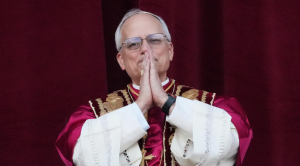A chilling prophecy by 16th-century French astrologer Nostradamus has resurfaced this week, with many speculating that it foretold the recent death of Pope Francis. Known for his cryptic and poetic predictions, Nostradamus—born Michel de Nostredame in 1503—has long fascinated believers and skeptics alike. His famed book Les Prophéties, published in 1555, contains hundreds of quatrains that some say predicted major world events centuries in advance.
Following the announcement of Pope Francis’ passing on Monday, 21 April, social media and various news outlets began circulating one particular quatrain believed to reference the end of his papacy. The pontiff, who was 88 at the time of his death, reportedly died from a cerebral stroke that progressed into a coma, eventually causing irreversible heart failure.
One of Nostradamus’ quatrains reads:
“Through the death of a very old Pontiff / A Roman of good age will be elected / Of him it will be said that he weakens his seat / But long will he sit and in mordant activity.”
Supporters of Nostradamus’ work claim this passage eerily aligns with Pope Francis’ advanced age and the details surrounding his death. Furthermore, the mention of a new pope being elected—one said to “weaken his seat” yet serve for a long period—has sparked speculation about the Vatican’s next chapter.
The prophecy doesn’t stop there. Nostradamus continues with a reference to a successor:
“A young man of dark skin with the help of the great king will deliver the purse to another of red colour.”
Interpretations of this passage vary. Some believe it hints at the race or origin of a future pope, or perhaps a shift in power dynamics within the Church. Others argue it may symbolize the exchange of influence between religious and political figures, perhaps pointing to alliances that could shape the future of the papacy.
While Nostradamus is credited with apparently predicting numerous historical events—including the rise of Adolf Hitler, the French Revolution, and the Great Fire of London—his writings are often vague and metaphorical. Scholars frequently debate the accuracy and validity of aligning modern events with his centuries-old verses. Critics argue that his prophecies are so broadly worded that they can be retrofitted to match a wide range of occurrences.
Regardless of one’s stance, the timing of this particular prophecy’s rediscovery has reignited public interest in Nostradamus’ work. Whether coincidence or clairvoyance, the connection between the prediction and Pope Francis’ passing has led many to wonder what else may lie hidden within Les Prophéties.
As the Vatican enters a nine-day mourning period, preparations are underway for Pope Francis’ funeral, scheduled to take place on Saturday, 26 April. Meanwhile, attention turns to the future of the Catholic Church and who will step into the role of the next pontiff—perhaps just as Nostradamus envisioned.









